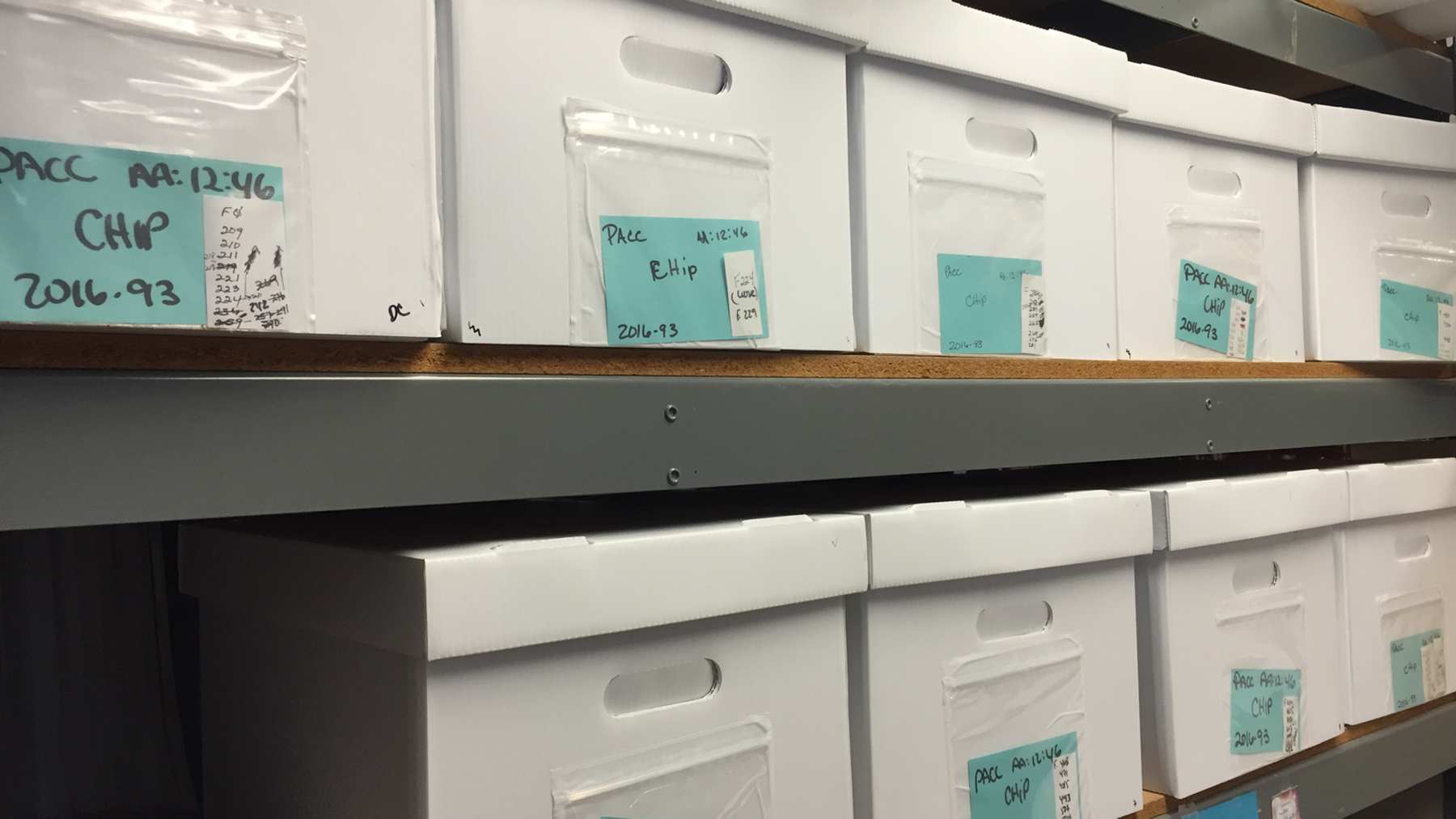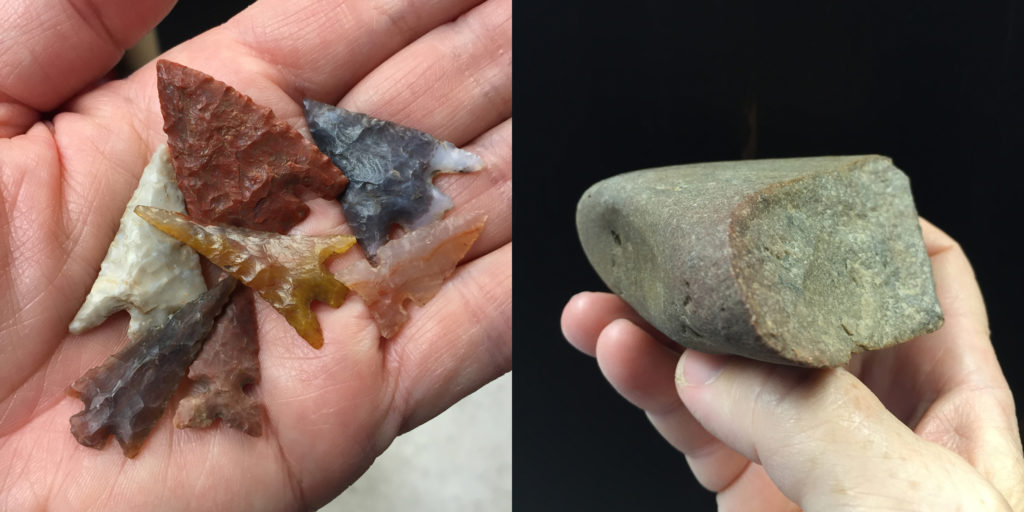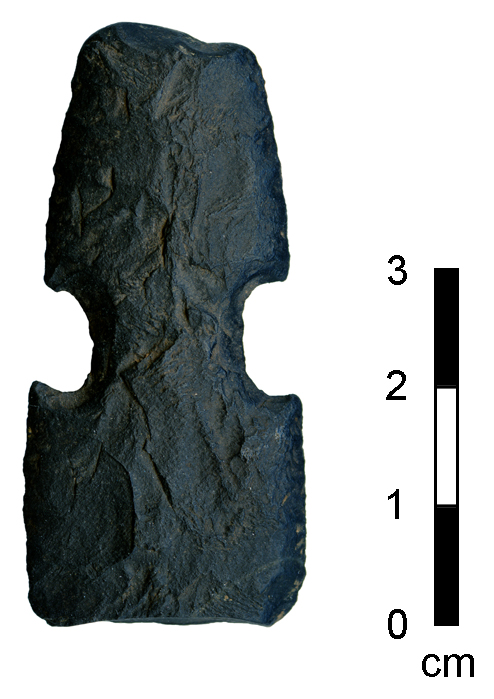
Artifact Curation and Archaeological Research: Keep Everything
R. J. Sliva, Desert Archaeology’s senior flaked stone analyst, shows how revisiting curated collections can answer new questions.
One of the first questions people usually ask archaeologists—after “What’s the coolest thing you’ve ever found?”—is “Where does all the stuff go?” The short answer is “to the museum,” which is our shorthand for “artifact curation facility.” Curation is a hot word these days, with everything from vintage vinyl records to assorted artisanal goat cheeses being overpackaged and described as a carefully curated collection. In an archaeological sense, however, artifact curation means that everything we collect in the field is inventoried, packed in approved containers, and stored in a secure, climate-controlled building into perpetuity.
We constantly talk about preserving the past, and this is one of the primary ways we do it. In the cultural resources management world, we have the opportunity to investigate and excavate archaeological sites because they lie in the path of unavoidable development. Most often, we cannot preserve the sites themselves, but the material artifacts—the tangible record of past peoples—are saved. Perhaps you have visited the Arizona State Museum (ASM), on the University of Arizona campus near the Main Gate. As impressive as the exhibits are, the artifacts on public display are a miniscule fraction of the collections contained on the upper floors of the building and in the old museum building across the street. These artifacts, most of which will never make their way into an exhibit case, are the foundation of the museum’s primary mission: to be a repository of cultural resources that can be revisited again and again.
Keeping collections into perpetuity—and keeping them accessible—ensures that future researchers are able to open new lines of inquiry as they develop new analytical techniques and interpretive perspectives. I have lost track of the number of visits I have made to the ASM repository over the course of my career as a flaked stone analyst, but three examples stand out. I’ll begin with the projectile points because it is easy to understand why a museum might want to hang onto them. They are aesthetically pleasing, and they are intuitively recognizable and comprehensible to non-archaeologists in a way that a denticulate or utilized flake might not be.

One handful is readily recognizable where the other maybe is not, but both types of artifacts are loaded with information. Ancestral Puebloan arrow points from the Kayenta area of northern Arizona (left), and a Hohokam core used for planing from southern Arizona (right).
Points are also some of the few flaked stone artifacts that have signature design elements that can be used to assess temporal or cultural affiliation, so curated point collections can be enormously useful when embarking on a new analysis. Sometimes it is helpful to go look at an entire site’s worth of projectile points, and other times a single point is the key to unraveling a mystery.
One particular entire-site assemblage came to my attention while compiling data for a book on Early Agricultural period points, submitted as part of the compliance process for Desert’s work at the San Pedro phase (the initial portion of the period, 1200-800 B.C.) Las Capas site in Tucson. In the interest of building a thorough database of point measurements, I examined all the points the museum has curated from a long list of the San Pedro and subsequent Cienega phase (800 B.C.-A.D. 50) sites I knew had been excavated in the Tucson area. While helping me locate these, now-retired ASM collections master Mike Jacobs noticed another site that had been collected recreationally and recorded in 1969 and 1970 by Edward Roland, a researcher from the U of A’s Lunar and Planetary lab (well before historic preservation laws were enacted that make such activities illegal on public land in Arizona). Roland turned over several cartons of artifacts to the museum in 1993, including over 100 projectile points. Because this site—now known as the Roland site—was located near Las Capas, Jacobs thought the points might be worth looking at.
They were. The collection from the Roland site turned out to contain every major Early Agricultural point type that was made from roughly 2100 B.C. to A.D. 50 in southern Arizona.

Points from the beginning (2100 B.C., upper left) to the end (A.D. 50, lower right) of the Early Agricultural period in the Tucson Basin, collected from the Roland site and curated at ASM.
No other Early Agricultural period site in the Tucson Basin has produced a point assemblage approaching the Roland collection’s combined diversity (the number of design types), richness (the number of points within each type), and unbroken temporal sequence. Most importantly for my study, the site also represents the second-largest concentration of Empire points in the Tucson Basin—a type that previously was known in significant numbers only at Las Capas. The revelation of so many Empires clustered at nearby Roland, separated only by the river, expanded my thinking about the how residents of Las Capas interacted with neighboring communities. The revelation of an unbroken chronological sequence of the complete suite of Early Agricultural period point designs at Roland should expand our thinking about the nature of settlement on the west side of the Santa Cruz. The Rosetta Stone is an imprecise analogy, as the Roland site’s points are not directly associated with dates—yet. But they raise tantalizing and important questions surrounding Early Agricultural population movement, social relations, and persistent places that will inform the research when the site is ultimately formally investigated.
The second example involves a single curated artifact. In 1995, Desert conducted excavations at Los Pozos, a large Late Cienega phase agricultural settlement in the Santa Cruz River floodplain. One of the pithouses—Feature 819—held a remarkable array of artifacts, including shaped stones, fossils, minerals, and 13 projectile points, carefully arranged to serve some ritual purpose.
Although some of the points are still unidentified and likely were imported from other regions, perhaps the most enigmatic flaked stone artifact in the array is a narrow, rectangular piece that tapers toward both ends, which are broken and ground, with large notches flaked into its long edges. At the time of the original analysis, it certainly didn’t look like anything else in the Los Pozos assemblage, nor did it particularly resemble any known designs from the Tucson Basin. We presumed it originally had been a larger piece that broke and then was reshaped through grinding (and, possibly, the notching) to be incorporated in the array.
Fast-forward 17 years to 2013, and Desert Archaeology returned to Los Pozos in advance of additional construction work at the site by Tucson Water. Yet again, a pithouse (Feature 2593) produced an enigmatic piece. This one at least was identifiable as being a projectile point, albeit one whose length, narrow blade, and narrow, short stem did not conform to any Early Agricultural period design I had seen in Arizona.
Still, this point was oddly familiar, nudging my memory toward something I knew I had seen before at Los Pozos. I went back to the museum, back to the box of artifacts from Feature 819, and back to the broken, narrow, ground and notched piece from the array, where I found the answer. The long point had reminded me of the piece from the array because the two artifacts are technologically identical. They were made using the same flaking technique on the same kind of fine-grained black metasedimentary stone, with the same widths and thicknesses at every measurement location, almost certainly flaked by the same knapper.

Comparative measurements of the two pieces. Left, reworked fragment from the array excavated in 1995; right, complete point from the 2013 excavation.
Were they intended to function together as a matching pair of points? Was one deliberately broken and modified with grinding and notching to be included in the Feature 819 array, or was it co-opted after breaking in an unrelated episode? What is the connection between the people who built Features 819 and 2593, which are roughly contemporaneous but located some 250 m apart in different areas of the site? Did the knapper give the modified piece to the people who assembled the array, or did they fish it out of a trash dump without knowing who made it? This discovery raised several questions that are as yet unanswered, but would not have been asked in the first place without the ability to revisit the earlier collection and physically compare the two artifacts side-by-side, taking detailed measurements that were not relevant in 1995 but became important in 2013.

Perhaps not quite as interesting to the uninitiated, but full of information on past human behavior. Artifact curation means debitage too.
As exciting as they are to revisit, projectile points typically account for only a tiny fraction of the entire flaked stone assemblage from any site. The bulk of any assemblage is composed of debitage—the waste flakes that are the byproduct of the manufacturing process, analogous to the wood shavings piled at the feet of a person whittling a block of wood into a sculpture. High numbers of flakes equate to high volumes of artifacts, which means multiple boxes that must be stored in artifact curation facilities. As space diminishes and costs go up, the value of storing what is essentially trash may not be immediately apparent. Consider, however, that each waste flake preserves a split second of human behavior in time, recording the physics of the stone-knapping action in the surfaces of the flake where they can be read by a trained eye, and the research potential of these collections becomes clear.
Desert Archaeology excavated a small parcel on the outskirts of Las Capas in 1998. This was followed by two investigations by SWCA, Inc., in the core of the site from 1998-1999 and 2002-2003. SWCA’s excavations featured an early San Pedro phase pithouse (Feature 600) that was packed with multitudes of small flakes, along with a dozen Empire points, 14 preforms, and 21 broken point or preform tips. SWCA’s India Hesse analyzed the artifacts and interpreted the combined points and bifacial thinning flakes (the term applied to the small debitage that results from point or biface manufacture) as reflecting intensive projectile point production within Feature 600.
When Desert returned to excavate several additional areas of Las Capas in 2008 and 2009, our work in an area adjacent to a SWCA locus encountered an extramural deposit of hundreds of small flakes, including numerous bifacial thinning flakes, but dating to the late San Pedro phase and featuring San Pedro points instead of Empire. This was a prime opportunity to compare the technological signatures of Empire and San Pedro point manufacture. Hesse graciously shared her point measurement data, which aided my analysis considerably, but differences in our debitage analysis methods meant that the two datasets could not be directly compared. But because the entire Las Capas assemblage was curated at ASM, even the piles of flaking waste, the problem was solved with a trip to collections to pick up a box, take direct flake measurements, and enter them into the Desert database. The results? The debitage from the earlier production area was larger, thicker, and more variable in size than the flakes from the later area. However, in both cases, the identified bifacial thinning flakes were of consistent sizes, while the bifacial thinning flakes found scattered across contemporaneous features were far more variable. This suggests that the people responsible for these deposits were individuals employing consistent techniques, at least within these concentrated production episodes.
Every archaeological analyst has similar stories about going back to curated collections to fill gaps in a dataset, improve a sample, or compare decades-old conclusions with current ones. The ability to return to the artifacts—particularly from older collections that may not have been completely analyzed, or analyzed at all—is a crucial factor in good science, and in continuing to build and improve our knowledge base. Artifact curation ensures that the past is preserved for the future.

Science depends on data, and data collection depends on constantly innovating new ways to assess artifacts. Yesterday’s trash is tomorrow’s treasure trove of information, so artifact curation is essential to our work. Luckily, the ASM collection is just about as large as this, but far better organized.
Resources
Arizona State Museum collections
Recurrent Sedentism and the Making of Place: Archaeological Investigations at Las Capas, a Preceramic Farming Community in the Tucson Basin, Southern Arizona, edited by S. M. Whittlesey, S. J. Hesse, and M. S. Foster, SWCA, Inc. (available at the Arizona State Museum library)
A Ritual Array of Artifacts from the Floor of Feature 819, by David A. Gregory (pdf)
San Pedro Phase Flaked Stone at Las Capas, AZ AA:12:111 (ASM): Technology and Social Dynamics, by R. Jane Sliva and Stacy L. Ryan (pdf; free site registration required)




